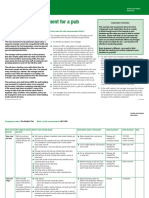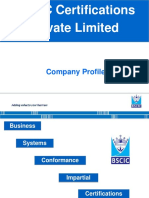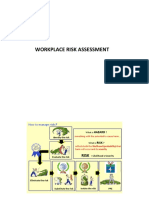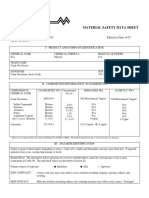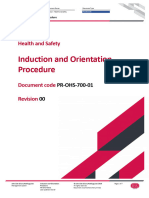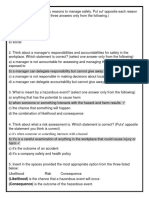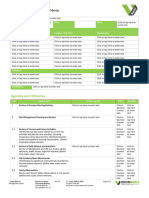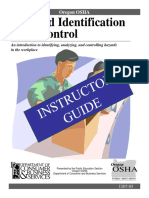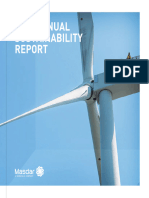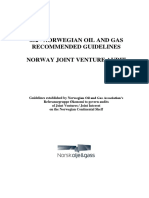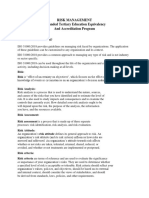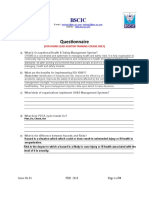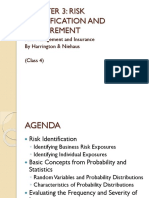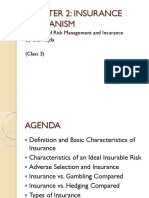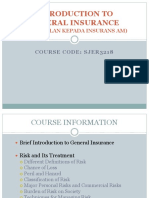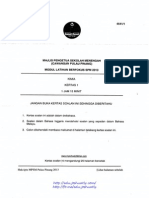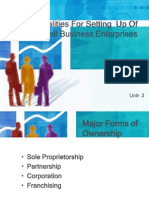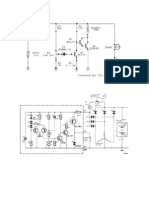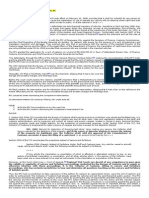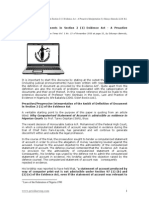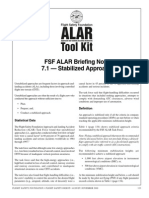CHAPTER 3: FUNDAMENTALS
OF RISK MANAGEMENT
Principles of Risk Management and Insurance
By G.E. Rejda
(Class 3)
�AGENDA
Meaning
of Risk Management
Objectives of Risk Management
Steps in the Risk Management
Process
Benefits of Risk Management
Personal Risk Management
�MEANING OF RISK MANAGEMENT
Risk Management is a process that identifies loss
exposures faced by an organization and selects the
most appropriate techniques for treating such
exposures.
Typically, risk managers use the term loss exposure to
identify potential losses. A loss exposure is any situation
or circumstance in which a loss is possible, regardless of
whether a loss occurs.
Example: A plant that may be damaged by an earthquake, or an
automobile that may be damaged in a collision.
New forms of risk management that consider both pure
and speculative loss exposures.
�OBJECTIVES OF RISK MANAGEMENT
Risk management has important objectives and
can be classified as before a loss occurs (preloss) and after a loss occurs (post-loss).
Pre-loss objectives:
Prepare for potential losses in the most economical
way preparation involves an analysis of the cost of
safety programs, insurance paid and the costs
associated with different techniques for handling
losses;
Reduction of anxiety worry and fear of certain loss
exposures;
Meet any legal obligations.
�OBJECTIVES OF RISK MANAGEMENT
Post-loss objectives:
Ensure survival of the firm the firm can resume at
least partial operations within reasonable time period
after the occurrence of loss;
Continue operating the ability to operate after a
loss is extremely important;
Stability of earnings maintained if the firm continues
to operate;
Continued growth of the firm development of new
products and services, M&A etc.;
Minimize the effects that a loss will have on other
persons and on society severe loss that adversely
affect employees, suppliers, creditors and the
community in general.
�STEPS IN THE RISK MANAGEMENT
PROCESS
There are 4 steps in the risk management
process:
Identify loss exposures;
Measure and analyze the loss exposures;
Select the appropriate combination of
techniques for treating the loss exposure;
Implement and monitor the risk management
program.
�EXHIBIT 3.1: STEPS IN THE RISK
MANAGEMENT PROCESS
�IDENTIFY LOSS EXPOSURES
Property loss exposures;
Liability loss exposures;
Business income loss exposures;
Human resources loss exposures;
Crime loss exposures;
Employee benefit loss exposures;
Foreign loss exposures;
Intangible property loss exposures;
Failure to comply with government laws
and regulations.
�IDENTIFY LOSS EXPOSURES
A risk manager has several sources of
information he or she can use to identify loss
exposures:
Risk analysis questionnaires and checklist to identify
major and minor loss exposures;
Physical inspection of company plants and its operation;
Flowcharts that show the flow of production and delivery;
Analysis of financial statements;
Historical loss data.
In addition, risk managers must keep abreast of
industry trends and market changes that can
create new loss exposures and cause concerns.
Example: rising workers compensation costs, effects of
M&A, exposure to acts of terrorism etc.
�MEASURE AND ANALYZE THE
LOSS EXPOSURES
Estimate the frequency and severity of loss for each
type of loss exposure:
Loss frequency refers to the probable number of losses that may
occur during some given time period;
Loss severity refers to the probable size of the losses that may
occur.
Once the risk manager estimates the frequency and
severity for each type of loss exposure, the various loss
exposures can be ranked according to their relative
importance.
The relative frequency and severity of each loss
exposure must be estimated so that the risk manager
can select the most appropriate technique or
combination of techniques, for handling each exposure.
�MEASURE AND ANALYZE THE
LOSS EXPOSURES
Loss severity is more important than loss frequency
because a single catastrophic loss could wipe out the
firm.
Must consider all losses that can result from a single
event:
The maximum possible loss (MPL) is the worst loss that could
happen to the firm during its lifetime;
The probable maximum loss (PML) is the worst loss that is likely
to happen;
Example: A plant was totally destroyed by a flood, the estimated
total replacement and other related costs at RM 25 million. Thus,
MPL is RM 25 million. It was also estimated that a flood causing
not more than RM 20 million of damage to the plant is so
unlikely, that would occur once in 50 years. Thus, PML is RM 20
million.
�SELECT THE APPROPRIATE COMBINATION OF
TECHNIQUES FOR TREATING THE LOSS
EXPOSURES
Broadly, can be classified as either risk
control or risk financing.
Risk control refers to techniques that
reduce the frequency and severity of
losses.
Major methods of risk control include:
Avoidance;
Loss prevention;
Loss reduction.
�SELECT THE APPROPRIATE COMBINATION OF
TECHNIQUES FOR TREATING THE LOSS
EXPOSURES
Risk Control Methods
Avoidance means a certain loss exposure is
never acquired, or an existing loss exposure is
abandoned.
Major advantage: the chance of loss is reduced to
zero if the loss exposure is never acquired;
In addition, if an existing loss is abandoned, the chance
of loss is reduced or eliminated;
Major disadvantage: it is not always possible, or
practical, to avoid all losses and exposures.
�SELECT THE APPROPRIATE COMBINATION OF
TECHNIQUES FOR TREATING THE LOSS
EXPOSURES
Risk Control Methods
Loss prevention refers to measures that
reduce the frequency of a particular loss.
E.g. Installing safety features on hazardous products
Loss reduction refers to measures that
reduce the severity of a loss after is occurs.
E.g. Installing an automatic sprinkler system
�SELECT THE APPROPRIATE COMBINATION OF
TECHNIQUES FOR TREATING THE LOSS
EXPOSURES
Risk financing refers to techniques that
provide for the funding of losses.
Major methods of risk financing include:
Retention;
Non-insurance Transfers;
Commercial Insurance.
�SELECT THE APPROPRIATE COMBINATION OF
TECHNIQUES FOR TREATING THE LOSS
EXPOSURES
Risk Financing Methods
Retention means that the firm retains part or
all of the losses that can result from a given
loss.
It can be either active or passive.
Retention is effectively used when:
No other method of treatment is available;
The worst possible loss is not serious;
Losses are fairly predictable.
The retention level is the dollar amount of
losses that the firm will retain:
A financially strong firm can have a higher retention
level than a financially weak firm;
The maximum retention may be calculated as a
percentage of the firms net working capital
(difference between companys current assets and
current liabilities).
�SELECT THE APPROPRIATE COMBINATION OF
TECHNIQUES FOR TREATING THE LOSS
EXPOSURES
Risk Financing Methods (Retention)
A risk manager has several methods for paying
retained losses:
Pay out of its current net income and treat losses as
current expenses for that year;
Unfunded reserve: losses are deducted from a
bookkeeping account;
Funded reserve: losses are deducted from a liquid
fund;
Credit line: funds are borrowed to pay losses as they
occur.
�SELECT THE APPROPRIATE COMBINATION OF
TECHNIQUES FOR TREATING THE LOSS
EXPOSURES
Risk Financing Methods (Retention)
A captive insurer is an insurer owned by a parent firm
for the purpose of insuring the parent firms loss
exposures:
A single-parent captive is owned by only one parent;
An association or group captive is an insurer owned by several
parents;
Many captives are located in the Caribbean because the
regulatory environment climate is favorable, low capital req. etc.
Captives are formed for several reasons, including:
The parent firm may have difficulty obtaining insurance;
Take advantage of favorable regulatory environment;
Costs may be lower than purchasing commercial insurance;
A captive insurer has easier access to a reinsurer;
A captive insurer can become a source of profit.
Premiums paid to a captive may be tax-deductible under certain
conditions.
�SELECT THE APPROPRIATE COMBINATION OF
TECHNIQUES FOR TREATING THE LOSS
EXPOSURES
Risk Financing Methods (Retention)
Self-insurance is a special form of planned retention
by which:
Part or all of a given loss exposure is retained by the firm;
A more accurate term would be self-funding;
Widely used for workers compensation and group health
benefits.
A risk retention group is a group captive that can
write any type of liability coverage except employer
liability, workers compensation and personal lines:
Federal regulation allows employers, trade groups,
governmental units, and other parties to form risk
retention groups;
They are exempt from many state insurance laws.
�SELECT THE APPROPRIATE COMBINATION OF
TECHNIQUES FOR TREATING THE LOSS
EXPOSURES
Risk Financing Methods (Retention)
Advantages
Save money
Lower expenses
Encourage loss
prevention
Increase cash
flow
Disadvantages
Possible higher
losses
Possible higher
expenses
Possible higher
taxes
�SELECT THE APPROPRIATE COMBINATION OF
TECHNIQUES FOR TREATING THE LOSS
EXPOSURES
Risk Financing Methods
A non-insurance transfer is a method other
than insurance by which a pure risk and its
potential financial consequences are transferred
to another party
Examples include contracts, leases, hold-harmless
agreements etc.
�SELECT THE APPROPRIATE COMBINATION OF
TECHNIQUES FOR TREATING THE LOSS
EXPOSURES
Risk Financing Methods (Non-insurance
transfer)
Advantages
Can transfer some
losses that are not
commercially
insurable
Save money (less
cost)
Can transfer
potential loss to
someone who is in a
better position to
exercise loss control
Disadvantages
Contract language may be
ambiguous, so transfer may
fail
If the other party fails to pay,
firm is still responsible for
the loss
Insurers may not give credit
for transfers
�SELECT THE APPROPRIATE COMBINATION OF
TECHNIQUES FOR TREATING THE LOSS
EXPOSURES
Risk Financing Methods (Insurance)
Insurance is appropriate for loss exposures that
have a low probability of loss but for which the
severity of loss is high.
5 key areas must be emphasized:
The risk manager must select the insurance coverages
needed.
A deductible is a provision by which a specified amount is
subtracted from the loss payment otherwise payable to the
insured;
An excess insurance policy is one in which the insurer does
not participate in the loss until the actual loss exceeds the
amount a firm has decided to retain.
The risk manager must select an insurer or several
insurers.
�SELECT THE APPROPRIATE COMBINATION OF
TECHNIQUES FOR TREATING THE LOSS
EXPOSURES
Risk Financing Methods (Insurance)
5 key areas must be emphasized:
The risk manager negotiates the terms of the
insurance contract.
A manuscript policy is a policy specially tailored for the firm;
Language in the policy must be clear to both parties;
The parties must agree on the documents (policy,
endorsements and forms) that will form the basis of the
contract;
Information concerning insurance coverages must be
disseminated to others in the firm;
The risk manager must periodically review the
insurance program
�SELECT THE APPROPRIATE COMBINATION OF
TECHNIQUES FOR TREATING THE LOSS
EXPOSURES
Risk Financing Methods (Insurance)
Advantages
Firm is indemnified for
losses
Uncertainty is reduced
Insurers may provide
other risk management
services
Premiums are taxdeductible
Disadvantages
Premiums may be costly
Opportunity cost should be
considered
Negotiation of contracts
takes time and effort
The risk manager may
become lax in exercising loss
control
�EXHIBIT 3.2: RISK MANAGEMENT
MATRIX
Which Technique Should Be Used?
�IMPLEMENT AND MONITOR THE
RISK MANAGEMENT PROGRAM
Implementation and monitoring of a risk
management program begins with a risk
management policy statement that:
Outlines the firms risk management objectives;
Outlines the firms policy on loss control;
Educates top-level executives in regard to risk
management process;
Gives the risk manager greater authority;
Provides standards for judging the risk managers
performance.
A risk management manual may be developed and
used to:
Describe some details the risk management program;
Useful tool for training new employees.
�IMPLEMENT AND MONITOR THE
RISK MANAGEMENT PROGRAM
A successful risk management program
requires active cooperation from other
departments in the firm too:
Accounting, Finance, Marketing etc.
The risk management program should be
periodically reviewed and evaluated to
determine whether the objectives are
being attained:
The risk manager should compare the costs
and benefits of all risk management activities.
�BENEFITS OF RISK MANAGEMENT
The firms pre-loss and post-loss objectives are
attainable.
A risk management program can reduce a firms cost of
risk:
The cost of risk includes premiums paid, retained losses, outside
risk management services, financial guarantees, internal
administrative costs, taxes, fees, and other expenses
Reduction in pure loss exposures allows a firm to enact
an enterprise risk management program to treat both
pure and speculative loss exposures.
Society also benefits since both direct and indirect
losses are reduced.
�PERSONAL RISK MANAGEMENT
Personal risk management refers to the
identification of pure risks faced by an
individual or family, and to the selection of
the most appropriate technique for
treating such risks.
The same principles applied to corporate
risk management apply to personal risk
management.


